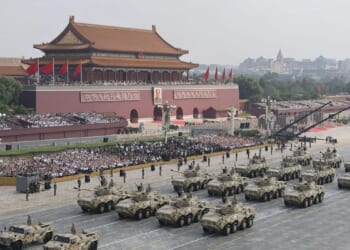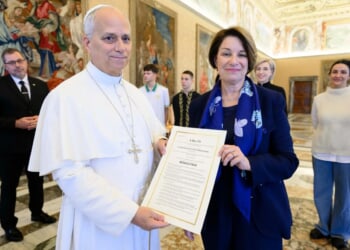Nicolas Kristof has been a longtime critic of Israel. Most recently, he has aggressively promoted notions that Israeli policies created Sudan-like hunger problems in Gaza, and that there has been equivalence of violence between past Arab and Jewish actions.
Kristof has chastised Trump because he “allowed the [Gaza] war and starvation to drag on,” and elsewhere that the U.S. is “underwriting mass starvation,” and “inflicting famine on children.” While there is evidence of substantial malnutrition, claims of mass starvation or famine are unfounded. Kristof references a New York Times report that only states, “there is impending famine,” based on the Hamas Ministry of Health’s claims of 111 hunger deaths since the beginning of the war. Hard to see how this qualifies as mass starvation.
To amplify the seriousness, a photo of an emaciated 18-month-old child was placed on its front page. Only after protests did the New York Times amend its story to indicate that the child “had pre-existing health problems affecting his brain and his muscle development,” but neglected to publish an accompanying photo of his robust-looking three-year-old sibling.
…[S]tarvation stories were based on incorrect data, and media outlets repeated each other’s alarming allegations without investigating the original data.
The most serious distortions are claims that Israeli policies have caused severe food shortages. A comprehensive study by the Begin-Sadat Center for Strategic Studies demonstrated that starvation stories were based on incorrect data, and media outlets repeated each other’s alarming allegations without investigating the original data.
The study demonstrates that the use of 500 trucks per day entering was an inappropriate measure of the minimum requirements. While Amnesty International reported that Gazans gained 44 percent of their food from domestic production, the study noted it was at most 15 percent. As a result, “throughout most of the war more provisions were delivered into Gaza than prior to October 7 [2023], by a margin greater than any credible estimates of loss of Gazan agricultural production.”
In mid-2024, U.N. agencies claimed that Israeli military operations had reduced the number of trucks entering Gaza by nearly 70 percent, painting a picture of deliberate strangulation. But Israeli records indicated deliveries in the months after the alleged drop were higher than the previous year. In late 2024, the U.N. quietly corrected its figures to align with the Israeli data, essentially admitting that the 70 percent decline had never actually occurred.
Of course, these facts do not negate the serious hunger problem, especially given the havoc accompanying the attempted distribution of food aid. But it does undermine the notion that there was inadequate food delivered and Kristof’s claims of Israeli complicity with the malnutrition (not starvation) being suffered by a significant share of the population.
In his most recent column, Kristof finds striking equivalences between Zionist and Palestinian actions and narratives: “Arabs massacred Jews in Hebron in 1929, and Jews slaughtered Arabs at Deir Yassin in 1948 and Qibya in 1953.” (Notice he gives one Arab but two Jewish examples.)
Kristof neglects to mention that the 1929 Hebron massacre was unprovoked, as was a similar pogrom in 1921, and there were continuous unprovoked attacks on Jewish settlements throughout the period. These attacks were instigated by Amin al-Husseini, who, despite these actions, was appointed Grand Mufti by the British and only relieved and forced to flee when he led an Arab uprising against the British during the 1930s.
It is worth noting that he then went to Iraq and instigated pogroms. When the British defeated an uprising he led, al-Husseini went to Germany and did propaganda work for the Nazis. Finally, when he was able to escape house arrest and came to Cairo in 1947, the Arab League selected him to be the leader of the Palestinian community.
By contrast, the two Jewish excesses Kristof cites were in the context of military conflicts. During April 1948, Zionists began clearing villages, including Deir Yassin, to open a lifeline to the besieged Jewish Jerusalem community. After receiving unexpected resistance, Zionists brutally responded, killing 110 Arabs, including many women and children. According to Benny Morris,
Most of the villages fled or were trucked through West Jerusalem and dumped at Muscara, outside the Old City walls. The atrocities were condemned by the Jewish Agency, the Haganah command, and the Yishuv’s two chief rabbis.
Arab officials more than doubled the death total and called for revenge, which soon took place. A week later, a medical convoy headed for Jerusalem was ambushed, and the majority of Jewish doctors and nurses were killed. A month later, the Zionist settlement of Kfar Etzion was overrun, and a true massacre occurred:
Groups of defenders carrying white flags emerged from bunkers and trenches. … The bulk of the defenders, more than a hundred men and women, were assembled in an open area … Then a photographer with a kaffiya arrived and took photographs. When the photographer stopped taking pictures fire was opened up on us from all directions. … Almost all of the men and women were murdered.
Between June 1949 and October 1954, Israel accused Jordan of violating the armistice agreement 1,612 times, killing at least 124 Israelis, wounding hundreds more. In an effort to prevent further attacks, Israel launched a reprisal raid on Qibya. Israeli forces destroyed 50 homes, killing 69 Jordanian civilians who were hidden inside. Its leader, Ariel Sharon, claimed he did not know the houses were occupied. In his autobiography, Warrior, Sharon wrote:
As I went back over each step of the operation, I began to understand what must have happened. For years Israeli reprisal raids had never succeeded in doing more than blowing up a few outlying buildings, if that. Expecting the same, some Arab families must have stayed in their houses rather than running away. In those big stone houses … some could easily have hidden in the cellars and back rooms, keeping quiet when the paratroopers went in to check and yell out a warning. The result was this tragedy that had happened.
Arab prewar actions were unprovoked killings of civilians, and their retaliation during wartime was complete massacres after rounding up Jewish prisoners. By contrast, Jewish excesses never included intentionally massacring entire communities and giving complete and heartfelt apologies for unjustified actions. Kristof should be condemned for not making these distinctions.
READ MORE from Robert Cherry:
False Claims Made by Globalist Anti-Israel Forces
The Hypocrisy of Zohran Mamdani’s Liberal Apologists
The ‘BBB’ Brings Accountability to the Food Stamp Program — Not Catastrophe
Robert Cherry is an American Enterprise Institute affiliate and author of the forthcoming Arab Citizens of Israel: How Far Have They Come? (Wicked Son, February 2026).















